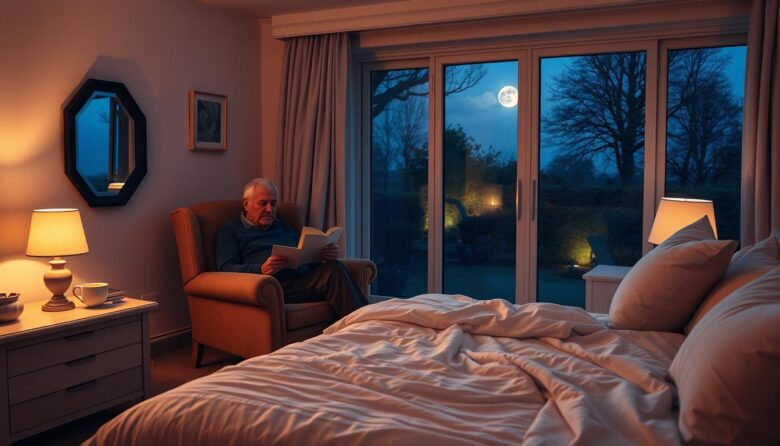Nearly 33% of American adults struggle with insufficient rest, according to the CDC. While many assume aging reduces the need for nightly recovery, older individuals still require 7-9 hours – matching younger adults’ needs. Maintaining consistent habits becomes vital for preserving physical vitality and cognitive sharpness over time.
This guide reveals how structured evening patterns combat common challenges like fragmented rest cycles and late-night wakefulness. We’ll explore science-backed methods to enhance nightly recovery while addressing age-related changes affecting natural rhythms. Proper preparation helps maintain independence and supports long-term wellness goals.
Recent studies show environmental adjustments and personalized schedules can transform rest quality. From lighting modifications to mindful relaxation techniques, small changes create compounding benefits. Caregivers will discover actionable steps to help loved ones achieve deeper, more restorative nights.
Contrary to popular belief, frequent disruptions aren’t an inevitable part of aging. Through strategic habit-building and professional-backed approaches, older adults can experience improved daytime energy and emotional balance. Let’s examine practical solutions that prioritize both comfort and results.
Understanding Sleep Challenges in Older Adults
Contrary to popular opinion, the need for sufficient nighttime recovery doesn’t diminish with advancing years. Research confirms adults over 60 require 7-9 hours daily – identical to younger counterparts. Biological shifts, however, create unique obstacles that demand targeted solutions.
The body’s internal clock naturally weakens with age, reducing melatonin production by 20-30% after 60. This hormonal shift makes falling asleep harder and decreases time spent in deep restorative phases. These changes explain why many experience lighter, fragmented rest despite adequate time in bed.
Chronic health conditions further complicate nightly patterns. Arthritis pain, respiratory issues, and medication side effects often disrupt natural rhythms. Nearly 40% of older adults with insomnia also manage multiple chronic illnesses, creating a cycle that worsens both physical health and rest quality.
Social perceptions pose additional barriers. Many accept frequent awakenings as inevitable rather than seeking solutions. This misconception prevents effective interventions for treatable issues like sleep apnea or restless leg syndrome – disorders affecting 1 in 4 older individuals.
Prioritizing consistent habits becomes essential for counteracting these effects. Simple adjustments to daily routines and environments can significantly improve outcomes when implemented strategically. Recognizing these challenges as manageable conditions opens doors to sustainable improvements in overall wellness.
Identifying Obstacles to a Restful Bedtime
Achieving quality rest involves recognizing hidden barriers that interfere with nightly recovery. Many factors – from biological changes to daily choices – disrupt natural rhythms. Addressing these challenges requires understanding their root causes and practical solutions.
Medical Conditions and Disruptive Habits
Health issues like sleep apnea create dangerous interruptions in breathing patterns. Left untreated, this condition increases risks for cardiovascular problems and cognitive decline. Similarly, restless legs syndrome triggers involuntary movements that delay relaxation.
Chronic pain from arthritis or neuropathy often worsens after dark. Discomfort creates a cycle where poor rest amplifies daytime symptoms. Medication side effects further complicate matters, with some prescriptions causing insomnia or frequent bathroom trips.
Daily habits also play a critical role. Consuming caffeine after noon or enjoying nightcaps disrupts natural wind-down processes. Irregular bedtimes confuse the body’s internal clock, making consistent rest harder to achieve.
The Impact of Blue Light and Device Use
Screens from phones, tablets, and TVs emit blue light that tricks the brain into daytime mode. This suppresses melatonin production by up to 30%, delaying drowsiness. Many unknowingly extend their wakefulness by scrolling through devices before bed.
Creating a tech-free buffer zone 90 minutes before bedtime helps reset circadian rhythms. Opting for printed books or calming music instead of screens allows natural tiredness to develop. These adjustments support deeper, more restorative rest cycles.
Benefits of a Consistent Bedtime Routine
Consistent evening habits act as anchors for physical and mental well-being. A predictable sequence of calming activities signals your body to shift gears, preparing for rest while lowering stress hormones. This daily practice strengthens natural rhythms, creating lasting improvements in overall health.
Aligning with your internal clock makes falling asleep easier at the desired time. Studies show regular patterns reduce nighttime awakenings by 35%, helping maintain uninterrupted recovery phases. The automatic nature of established habits also eliminates evening decision-making, freeing mental energy for relaxation.
Improved sleep quality directly enhances daytime alertness and emotional stability. Those maintaining structured pre-bed rituals report better focus and memory retention throughout their waking hours. The stability also supports cardiovascular function and immune responses over time.
Beyond physical advantages, consistent routines foster emotional security. Knowing what comes next reduces anxiety linked to uncertainty, particularly valuable during life transitions. This predictability helps regulate appetite patterns and medication effectiveness, creating compounding wellness benefits.
Implementing personalized wind-down activities strengthens both mind and body connections. From reading to gentle stretches, these practices build resilience against daily stressors while promoting longevity. The right bedtime routine becomes a cornerstone for vibrant health at any age.
Designing a “sleep routine for seniors”
Crafting an effective nighttime schedule requires strategic planning tailored to individual needs. Start by choosing fixed bed and wake times that align with natural energy patterns – even on weekends. This consistency trains the brain to recognize when to wind down.
Personalization matters. Consider medication schedules, mobility needs, and preferred activities when building evening habits. Most specialists suggest dedicating 30-120 minutes for gradual relaxation. Set phone alerts to begin the process at the same time nightly.
Incorporate multi-sensory cues to reinforce the transition. Dim lights signal darkness approaching, while soft music lowers heart rates. Choose breathable fabrics for nightwear to enhance physical comfort during rest periods.
Build flexibility for unexpected events without abandoning core elements. A shortened version of the routine maintains rhythm better than skipping entirely. Review the plan quarterly or after health changes to ensure continued effectiveness.
Regular evaluation helps adapt to evolving needs. Track energy levels and rest quality to identify necessary adjustments. Small tweaks preserve the structure’s benefits while accommodating life’s natural shifts.
Steps to Create a Calming Bedtime Routine
Building sustainable evening habits starts with two core elements: timing and transition rituals. These components work together to reinforce natural biological patterns while reducing mental stimulation before rest.
Setting a Regular Sleep Schedule
Fixed timings form the backbone of effective nightly recovery. Begin by calculating backward from your desired wake-up time – subtract 7-9 hours to find the ideal lights-out moment. Stick to this schedule seven days weekly, including weekends.
Caregivers can support consistency through visual reminders like wall clocks or sunset-simulating lamps. Research shows maintaining identical bed and rise times reduces next-day fatigue by 42% compared to variable schedules.
Establishing Pre-Sleep Rituals
Initiate wind-down activities 45 minutes before bedtime. Dim household lighting by 50% to trigger melatonin release. Layer calming actions like warm showers and soft music to create predictable signals for relaxation.
Repeating the same sequence nightly builds powerful associations between these actions and drowsiness. Those who maintain structured pre-rest rituals fall asleep 28% faster than those with erratic habits, according to sleep clinic data.
Creating a Soothing Sleep Environment
Crafting an ideal nighttime space requires attention to three key elements. Strategic adjustments help maintain natural rhythms while minimizing disruptions. Body temperature regulation proves essential – studies show 65-68°F optimizes comfort and supports physical changes during rest.
Optimizing Lighting, Temperature, and Noise
Light exposure significantly impacts rest quality. Install blackout curtains to block streetlights while using warm-toned bulbs in evening hours. A small flashlight with red-spectrum illumination allows safe movement without disrupting drowsiness.
Sound management enhances relaxation. Identify buzzing electronics or outdoor noises first. Soft earplugs or white noise machines mask disturbances when complete silence isn’t possible. Pair these with temperature control for compounded benefits.
Bedding materials directly affect thermal comfort. Moisture-wicking sheets paired with breathable blankets help maintain ideal conditions. Regularly assess mattress support and pillow alignment to prevent discomfort that might interrupt rest cycles.
Declutter surfaces and remove work-related items to strengthen mental associations with relaxation. Proper ventilation reduces allergens, while humidity levels between 30-50% prevent dry airways. These steps transform bedrooms into sanctuaries promoting consistent recovery.
Incorporating Relaxation and Mindfulness Techniques
Mental calmness strategies provide accessible pathways to improve nightly recovery. These practices address stress reduction while supporting the body’s natural wind-down processes. Research indicates regular use enhances both physical relaxation and emotional balance.
Meditation Methods
Guided sessions lasting 10-15 minutes before bed create focus shifts away from daily worries. Body scan techniques help release muscle tension accumulated during daytime activities. Apps offering nature sounds or voice-led sessions simplify implementation for beginners.
Consistency matters more than duration. Even 5-minute practices strengthen neural pathways linked to calmness over time. Pairing meditation with soft lighting maximizes its stress-relieving effects.
Breathing Exercises
Controlled respiration triggers immediate physiological changes that lower heart rates. The 4-7-8 method (inhale 4 seconds, hold 7, exhale 8) proves particularly effective for reducing anxiety. Alternate nostril breathing balances energy levels while preparing the mind for rest.
These techniques work best when combined with comfortable seating positions. Track progress through journaling improvements in relaxation depth and morning alertness. Over weeks, these habits become automatic responses to evening tension.



